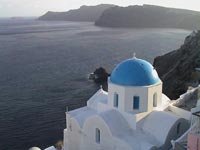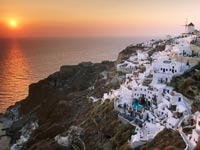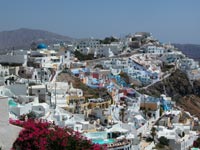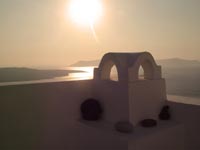 Santorini, like most of the Cycladic Island, has a rich history.
Santorini is plenty of archaeological sites which proves the first man presence on the island back to the Neolithic Period. Santorini history had the same evolution that in the other islands of the Cyclades. Santorini, like most of the Cycladic Island, has a rich history.
Santorini is plenty of archaeological sites which proves the first man presence on the island back to the Neolithic Period. Santorini history had the same evolution that in the other islands of the Cyclades.
An important civilization seems to have existed near Akrotiri, at the south of the island, next to the famous Red beach, dating back to 3600 BC. It was proved that Akrotiri was a Minoan city, like those found in Crete. The houses were plenty of frescos and pottery showing naturalistic landscapes or animals or humans. In ancient time, Santorini , then called Strongili (means rounded in greek), was the victim of an enormous volcano eruption dating back to 1500 BC and what remained today are Thera, Therasia and Aspronisi.
 Santorini history says that the explosions created huge waves which washed the shores of the surrounding islands and Crete. The consequence of that explosion is that a part of the island sank and the earthquakes destroyed all the rest of the island. Many people relate the sinking of the island to the mythical Atlantis(check the links). Santorini history says that the explosions created huge waves which washed the shores of the surrounding islands and Crete. The consequence of that explosion is that a part of the island sank and the earthquakes destroyed all the rest of the island. Many people relate the sinking of the island to the mythical Atlantis(check the links).
Santorini history says that around 1300 BC, Phoenicians settled for five generations.
Around 1115 BC, the island was colonised by Lacedaemonian.
Around 825 BC, the Phoenician alphabet was imported on the island, in Milos and Crete and the Hellenic language was created.
In the 7th and 6th centuries BC, Thera shared relations with most of the trade islands of Greece, Corinth and Attica.
In 300-145 BC, during the Hellenistic Period, Thera, for its position in the Cyclades, became a important strategical naval base.
From 197 BC to 726 AC, Santorini history sais that the volcano exploded four times.
 Between 1200 AC and 1579 AC, the islands saw the occupation by the Byzantines and the Venetians. Between 1200 AC and 1579 AC, the islands saw the occupation by the Byzantines and the Venetians.
From 1579 to 1821 AC Santorini was occupated by the Turkish until the Greek Revolution.
Santorini is one of the most popular destinations of Greece and it is known as one of the most spectacular landscape in the world. Every year, thousands of visitors go to Santorini to discover the famous submerged caldera, the volcano's crater which is situated today in the middle of a 32 square miles basin of water. Around the basin, hanging on cliffs of 150m to 300m height, you can find one of the most beautiful traditional villages of the Cyclades.
 White Cycladic houses and blue painted windows fighting against black volcanic rocks rising from the sea, is a spectacle that will inspire more than an artist...
This villages are Fira, Firostefani, Immerovigli and Oia. White Cycladic houses and blue painted windows fighting against black volcanic rocks rising from the sea, is a spectacle that will inspire more than an artist...
This villages are Fira, Firostefani, Immerovigli and Oia.
In ancient times, the shape of Santorini was circular and that was the reason it was also called Strongili (means circular in Greek).
The volcano's eruption destroyed the centre of the island, which sank, creating today's Caldera.
The first eruption of the Volcano (around 1500 BC) would be responsible for the destruction of the Minoan civilisation in Crete.
The last eruption in Santorini dates to 1956 and today, the volcano is still active.
It is told that the destruction of Santorini could be related to the mythical Atlantis. |

